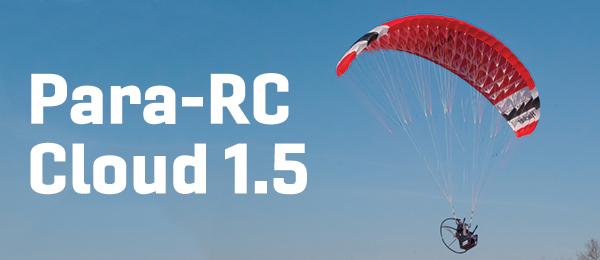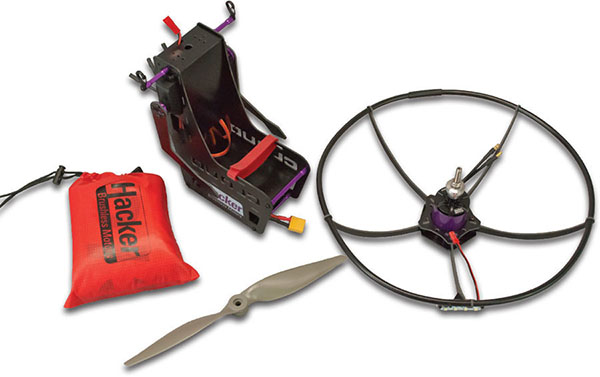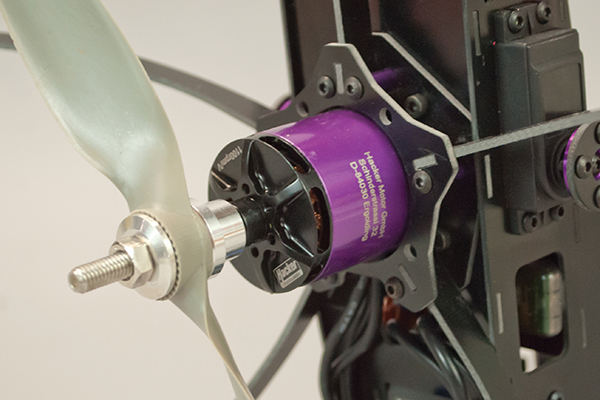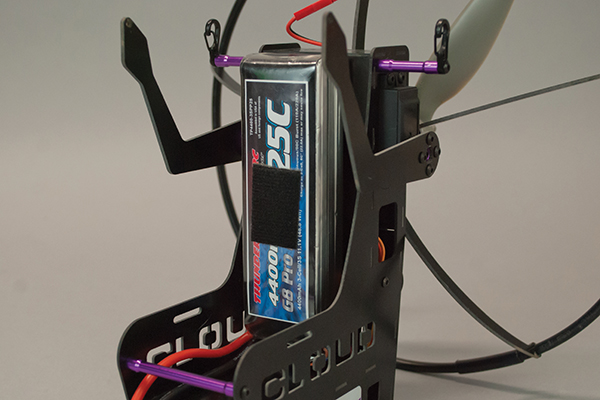Para-RC Cloud 1.5

Written by Terry Dunn
Take the leap into powered paragliding
As seen in the July 2021 issue of Model Aviation.
Review

POWERED PARAGLIDING has become popular with full-scale aviation enthusiasts. The basic idea is to strap an engine and propeller to your back and fly around (slowly) beneath a parachute-like wing. It is a relatively simple and safe way to dangle your feet in the sky. You do not even need a pilot’s license.
RC modelers can also try powered paragliding with the Para-RC Cloud 1.5 from Hacker Motors USA. This 1/5-scale rendition of a powered paraglider (PPG) is propelled by an electric motor and uses standard radio gear. It is a unique RC model that offers an equally distinct flying experience.
About the Cloud 1.5
The Cloud 1.5 has two main components: the wing and the paramotor. The wing is made of ripstop nylon. Although it comes packaged in a carrying pouch measuring roughly 6 inches square, it unfurls to a wingspan of more than 95 inches, with a wing area greater than 16 square feet. That’s a big wing!
No assembly is required for the wing. All of the risers and brake lines are attached at the factory. I’m not sure what material these lines are made of, but it’s stout stuff. The clips and rings that are required to connect these lines to the paramotor are preattached as well.


All of the power system and onboard radio components are located on the paramotor. As you would expect, this assembly resembles a seat with a pusher motor on the back. You could even set a lightweight doll in the seat for a fun, scalelike effect. The paramotor is constructed primarily of fiberglass components with purple-anodized aluminum standoffs. The quality of these components is excellent, and it is well assembled.
The included power system consists of a Hacker A30-8XL V4 brushless motor that is paired with a Hacker X55 ESC. It’s nice gear. An APC 10 × 5E propeller is also provided. The propeller in my kit was a loose fit on the 6mm shaft of the propeller adaptor and no spacer was provided. I corrected this with a 6mm spacer from my stash of spare propellers.
A 3S LiPo battery of 3,000 to 5,000 mAh is required to complete the power system. I have used 3,300 mAh and 4,400 mAh batteries in my model. The battery I use most often is a Thunder Power 4,400 mAh G8 Pro Lite pack with a 25C discharge rate.
Two digital servos are included with the Cloud 1.5. One servo is mounted on each side of the paramotor. These servos are fitted with long fiberglass arms that emulate the actual arms of a PPG pilot. The servos steer the model by pulling the brake lines on the wing.
The final component of the included electronics is a capacitor with standard servo leads. This unit can be plugged into any open channel on the receiver. It is intended to stabilize the voltage going into the receiver and servos.
You will need to provide a radio system with at least three channels. Although mounting space within the paramotor is not critical, you probably want to use a smaller receiver. I used a Spektrum iX12 transmitter paired with a Spektrum AR410 receiver.
Assembling the Cloud 1.5
Out of the box, the motor is attached to a fiberglass mount that also has an integrated cage to isolate the propeller. It is a good idea to make sure the factory-installed screws on the mount are securely tightened. These button-head screws require a 2mm hex wrench.
One of the first steps in assembling the Cloud 1.5 is to attach the motor mount to the back of the paramotor. It is important to ensure that the motor assembly is installed in the correct orientation. This allows all of the parts to interface correctly and also aims the included LED lights toward the wing for night flying. The manual provides excellent guidance.


Special radio mixing is required to control the Cloud 1.5. The manual describes the desired servo movement for each control input, but it does not offer specific steps for configuring the necessary mixes in your transmitter. That is understandable because each brand of radio has unique programming functions and methods.
The good news here is that there are simple options for getting the correct control setup. Owners of Jeti radios can download a model profile for the Cloud 1.5 from the Hacker Motors website. This file configures all of the necessary mixes when loaded onto a Jeti transmitter.
Those with other brands of radios can purchase the Para-RC Mix for roughly $20. This small circuit board is inserted between the servos and receiver. It provides all of the necessary control functions without having to program any mixes on your transmitter. I chose to use the Para-RC Mix.
I mounted my receiver with hook-and-loop tape. It is located slightly below the servos. Although I could have inserted the receiver through cutouts in the fiberglass side plates of the paramotor, I wanted better access to ensure that all of the wiring was secure and tidy. I temporarily disassembled the paramotor, routed all of the wires as cleanly as I could, and locked them in place with a few zip ties.
After setting up the radio system, I discovered that the servo arms were not in the correct neutral position. The bottom edge of the upper arms (above the "elbow") should be horizontal. I removed the servo arms from the servos and repositioned them on the servo output splines to achieve the correct orientation.


The flight battery can be mounted vertically against the backrest of the paramotor or on either of the horizontal platforms. I use the vertical location when flying with 4,400 mAh batteries and the horizontal location with 3,300 mAh batteries. Hook-and-loop tape works well to secure the battery. The included hook-and-loop strap can be utilized as well. With either size of battery, the attachment posts for the wing risers must be in the forwardmost position for the model to balance as shown in the manual.
Flying the Cloud 1.5
If assembling the Cloud 1.5 does not convince you that it is a unique type of RC aircraft, your first trip to the flying field certainly will. The techniques required to handle, launch, and fly the Cloud 1.5 are quite different from anything else I have flown. Open your mind and prepare for a new experience.
I suggest that you heed the manual’s recommendation to fly the Cloud 1.5 only in calm conditions. If the wind gets above roughly 5 mph, this aircraft becomes a handful to manage on the ground and in the air.
After unpacking the wing from the carrying pouch, you must take care to avoid fouling any of the risers or brake lines. It is not difficult to manage as long as you are attentive, but you might find yourself dealing with a few tangles if you are not careful.
I prefer to connect the risers and brake lines to the paramotor as soon as I unpack the wing. I then cover the collapsed wing with a beach towel until I am ready to fly. This prevents a rogue breeze from deploying the wing and dragging the Cloud 1.5 downwind.
It took a little practice to find a launching technique that works well for me. With the wing spread out on the ground, I hold the bottom side of the paramotor and advance the throttle to half power. Taking one step forward into the wind "inflates" the wing. I then raise the paramotor through a stiff-armed arc and release it above my head. The Cloud 1.5 generally departs without losing any altitude.
The Cloud 1.5 is recommended for experienced pilots. This might seem counterintuitive because the model is such a docile flier. In fact, when flying within its intended flight envelope, the Cloud 1.5 is extremely sedate and graceful. It is the kind of model where you can take a chair to the pilot box and enjoy an afternoon full of laid-back circuits around the patch.
The need for flying experience becomes apparent when you start jockeying the throttle. Erratic changes in power will cause the Cloud 1.5 to swing back and forth like a pendulum. This usually results in a few seconds of herky-jerky flying before order is restored. However, failure to get those oscillations under control could lead to a crash (yes, parachutes can crash). I think that most sport pilots will quickly adapt to the gradual power transitions that are key to making this model fly smoothly.


Although the Cloud 1.5 is sensitive to throttle changes, directional changes are much more predictable and intuitive. Even with large control inputs, the model does not react harshly. Right and left turns are like a motorcycle slowly leaning into a curve. I often set the throttle to hold altitude and fly the model using only the right stick to carve graceful circuits around the field.
I like to think of myself as a competent pilot, but it took me a few flights to adapt to the Cloud 1.5’s unique control response. I even had a few minor crashes and rough landings as I figured things out. On a related note, the paramotor is very tough—no damage!
Cruising speed for this airplane seems like little more than a brisk walk. Most of my flight time is spent at half-throttle or less. The power system provides a lot of thrust, but it is rarely necessary to tap into all of it. This aircraft’s low power demands allow me to easily fly for 12 minutes and longer with a 4,400 mAh battery.
Sunset is no reason to stop flying the Cloud 1.5. The included LED lights do a wonderful job of illuminating the entire wing. Visibility and orientation are no problem. This, and the aircraft’s slow flight speed, actually make it an ideal night flier. Fun stuff!
The Cloud 1.5 is capable of mild aerobatics if you dare. Jamming in full throttle will cause the model to perform something like a backflip as the paramotor loops around the wing. It’s not pretty, but this unexpected move is a fun little parlor trick to occasionally throw into the mix.
Landing the Cloud 1.5 is much as you would imagine with landing a parachute. Physics does most of the work for you. Just kill the throttle and pull back on the control stick to slow your ground speed before touchdown. If there is any wind when you land, you will want to quickly collapse the wing to prevent any unintentional "taxiing."
Final Approach
I really enjoy unique flying machines. The Para-RC Cloud 1.5 fits that description in many respects. Previous modeling experience is a definite advantage, but you can bet that this aircraft is going to teach you a fun lesson or two. It will then reward you with graceful, slow-motion flights during the day or evening.
SOURCES:
APC Propellers
(530) 661-0399
Spektrum
(217) 352-1913
Thunder Power
(702) 228-8883










1 comments
Para cloud
Add new comment